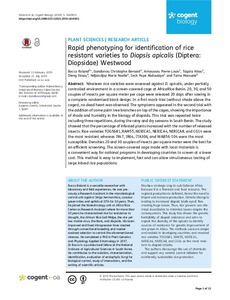| dc.contributor.author | Roland, B. |
| dc.contributor.author | Bernard, G.C. |
| dc.contributor.author | Pierre-Louis, A. |
| dc.contributor.author | Togola, A. |
| dc.contributor.author | Ibnou, D. |
| dc.contributor.author | Noelle, N.M. |
| dc.contributor.author | Abdoulaye, S.P. |
| dc.contributor.author | Tamò, M. |
| dc.date.accessioned | 2019-12-04T11:36:47Z |
| dc.date.available | 2019-12-04T11:36:47Z |
| dc.date.issued | 2019-08-18 |
| dc.identifier.citation | Roland, B., Bernard, G.C., Pierre-Louis, A., Togola, A., Ibnou, D., Noelle, N.M., ... & Tamo, M. (2019). Rapid phenotyping for identification of rice resistant varieties to Diopsis apicalis (Diptera: Diopsidae) Westwood. Cogent Biology, 5(1), 1-12. |
| dc.identifier.issn | 2331-2025 |
| dc.identifier.uri | https://hdl.handle.net/20.500.12478/6348 |
| dc.description | Open Access Journal |
| dc.description.abstract | Nineteen rice varieties were assessed against D. apicalis, under partially controlled environment in a screen-covered cage at AfricaRice-Benin. 20, 30, and 50 couples of insects per square meter per cage were released 20 days after sowing in a complete randomized block design. In a first mock-trial (without shade above the cages), no dead heart was observed. The symptoms appeared in the second trial with the addition of some palm tree branches on top of the cages, showing the importance of shade and humidity in the biology of diopsids. This trial was repeated twice including three repetitions, during the rainy and dry seasons in South Benin. The study showed that the percentage of infested plants increased with the number of released insects. Rice varieties TOG5681, RAM55, NERICA1, NERICA4, NERICA8, and CG14 were the most resistant whereas IR47, IR64, ITA306, and WAB56-104 were the most susceptible. Densities 20 and 30 couples of insects per square meter were the best for an efficient screening. The screen-covered cage made with local materials is a convenient way for national programs in developing countries to screen at a lower cost. This method is easy to implement, fast and can allow simultaneous testing of large inbred rice populations. |
| dc.format.extent | 1-12 |
| dc.language.iso | en |
| dc.rights | CC-BY-4.0 |
| dc.subject | Diptera |
| dc.subject | Diopsidae |
| dc.subject | Benin |
| dc.subject | Rice |
| dc.subject | Population |
| dc.subject | Phenotypes |
| dc.subject | Disease Resistance |
| dc.subject | Humidity |
| dc.title | Rapid phenotyping for identification of rice resistant varieties to Diopsis apicalis (Diptera: Diopsidae) Westwood |
| dc.type | Journal Article |
| dc.description.version | Peer Review |
| cg.contributor.crp | Grain Legumes |
| cg.contributor.affiliation | University of Abomey-Calavi |
| cg.contributor.affiliation | Université Catholique de l'Afrique de l'Ouest |
| cg.contributor.affiliation | International Institute of Tropical Agriculture |
| cg.contributor.affiliation | Africa Rice Center |
| cg.contributor.affiliation | Ministre de l’agriculture et de l’équipement rural du Sénégal |
| cg.coverage.region | Africa |
| cg.coverage.region | West Africa |
| cg.coverage.country | Benin |
| cg.creator.identifier | Abou TOGOLA: 0000-0001-6155-8292 |
| cg.creator.identifier | Manuele Tamò: 0000-0002-5863-7421 |
| cg.researchtheme | PLANT PRODUCTION & HEALTH |
| cg.isijournal | ISI Journal |
| cg.authorship.types | CGIAR and developing country institute |
| cg.iitasubject | Pests Of Plants |
| cg.iitasubject | Plant Health |
| cg.iitasubject | Plant Production |
| cg.journal | Cogent Biology |
| cg.howpublished | Formally Published |
| cg.accessibilitystatus | Open Access |
| local.dspaceid | 107759 |
| cg.targetaudience | Scientists |
| cg.identifier.doi | https://dx.doi.org/10.1080/23312025.2019.1649851 |

